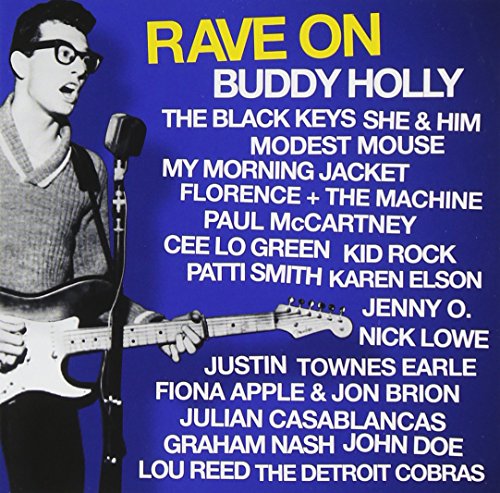
Various Artists
Rave On Buddy Holly
Release Date: Jun 28, 2011
Genre(s): Pop/Rock, Contemporary Pop/Rock, Tribute Albums
Record label: Hear Music
Music Critic Score
How the Music Critic Score works
Buy Rave On Buddy Holly from Amazon
Album Review: Rave On Buddy Holly by Various Artists
Very Good, Based on 12 Critics
Based on rating 5/5
When Buddy Holly died in February 1959 - in the plane crash that also claimed Ritchie Valens and the Big Bopper - he was just 22 and had only been a star since the fall of '57, when his first single with the Crickets, "That'll Be the Day," went to Number One. But in that time, Holly recorded a full, prophetic body of work, setting a big part of the stage for the British Invasion with his savvy, forthright desire and pop-hook allure charged with Fender sting and country-blues jump. Not surprisingly, Paul McCartney (who owns Holly's publishing catalog) and ex-Hollie Graham Nash pay engaging tribute here.
Based on rating 8.9/10
I’ll assume I’m not alone in having my first conscious memory of Buddy Holly be from the song of the same name by Weezer on their seminal debut. For a few months you couldn’t listen to alt rock radio or tune in to an afternoon of MTV without being bombarded with the implication that Buddy Holly, whoever he may be, was not the coolest dresser in town. What I didn’t realize at the time was that I knew Buddy Holly; I knew him without knowing I knew him.
Based on rating A-
Tribute albums are usually mawkish, well-meaning bores. Not Rave On Buddy Holly: Nineteen acts interpret proto-rocker Holly’s canon with vigorous invention. Lou Reed turns ”Peggy Sue” into a predatory pursuit; Florence + the Machine crash and clang, making the title of ”Not Fade Away” literal; Paul McCartney howls ”It’s So Easy” like an amped-up bluesman.
Based on rating B
An album of Buddy Holly covers is pretty daunting. He arguably invented rock ‘n’ roll before the age of 22. His backing band, the Crickets, supposedly inspired the Beatles’ name. And Rivers Cuomo looks just like him. Fortunately, the artists covering Holly’s biggest hits on Rave On Buddy ….
Based on rating 7/10
I’ve often wondered how ‘50s rocker Buddy Holly would have evolved had he not unfortunately and tragically died young at the age of 22 in a 1959 Iowa plane crash that not only dimmed his bright light, but also those of Ritchie Valens and J. P. “The Big Bopper” Richardson.
Based on rating 7/10
In some respects, Rave On Buddy Holly is a standard tribute album: it salutes a legend by rounding up classic rockers and hipsters to cover his canon, a practice that has been in place for nearly a quarter-century. In another regard, Rave On Buddy Holly is quite different. Encouraged by producer Randall Poster, the 19 artists involved do not settle for mere replications of Buddy’s hits, they play fast and loose, sometimes radically reinterpreting the original.
Based on rating 3/5
Part of the fun of tribute albums is seeing which unlikely artists claim to have been influenced by the honoree. Considering that Buddy Holly's proto-rock-and-roll has inspired nearly all popular music since his death in 1959, it's not surprising to see diverse artists on this star-studded compilation. Additionally, Holly's four-chord simplicity is practically a blank canvas, so it's interesting to see what they do with the material.
Based on rating 2.0/5
An explanation for the continuing endurance of Buddy Holly’s musical legacy can probably be boiled down to one word: simplicity. The bespectacled pioneer’s invention (that is, rock n’ roll) was a fresh sound drawn from disparate influences and then refined into its purest form—essentially, a four-chord distillation of country, blues, and rockabilly that tapped into the pathos of a younger generation. The drawback of such a legacy, of course, is that every few years audiences are subjected to yet another collection of artists attempting to put their half-assed stamp on Holly’s prolific work.
Based on rating 3.8/10
Buddy Holly was a singular musician who rose and fell in the era after rock'n'roll had become a distinct art form but before it had become art per se-- in the time, basically, between Elvis and the Beatles. His best songs are spare, nervy miniatures about puppy love riddled by anxiety-- an anxiety Holly made manifest in itchy percussive tracks and an inability to sing more than two lines without breaking into hiccups, the musical equivalent of sweaty palms. (This was in the late 1950s, when non-verbal ejaculations-- vocal or rhythmic-- were the closest a pop singer could get to talking about sex, a time when sex was broken down into gesture and metaphor).
Opinion: Excellent
A wonderful testament to Holly’s songwriting prowess, longevity and legacy. Mischa Pearlman 2011 Anyone who’s ever stumbled across the likes of The Royal Philharmonic Orchestra Plays the Music Of R. E.
Opinion: Excellent
It’s no small achievement that bespectacled ’50s rock icon Buddy Holly—who was tragically killed in a 1959 plane crash, aged 22—still inspires countless artists today. However, his impact runs much deeper than merely informing some retro, geek-chic fashion aesthetic or providing a kitschy, Happy Days-themed hook for a Weezer song. Ample proof is found on Rave On Buddy Holly, which pays tribute to Holly in remembrance of his coming 75th birthday not by producing carbon copies of the originals but rather by capturing each contributor enjoying the freedom to rework their track with their own style.
Opinion: Very Good
During the late ‘50s, Buddy Holly helped pioneer a new kind of music – rock and roll, a country/R&B hybrid driven by shuffling backbeats and electric guitars – that became the definitive art form of an entire century. He would’ve turned 75 this September. Unfortunately, Holly’s career ended soon after it started, coming to an abrupt halt in a plane crash that snuffed out the flames of three fast-burning newcomers.
'Rave On Buddy Holly'
is available now

